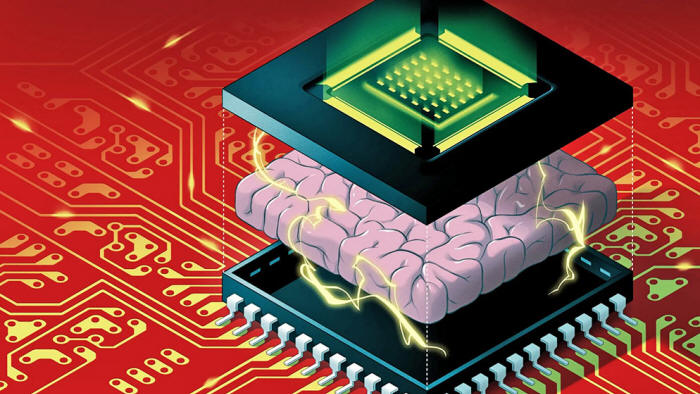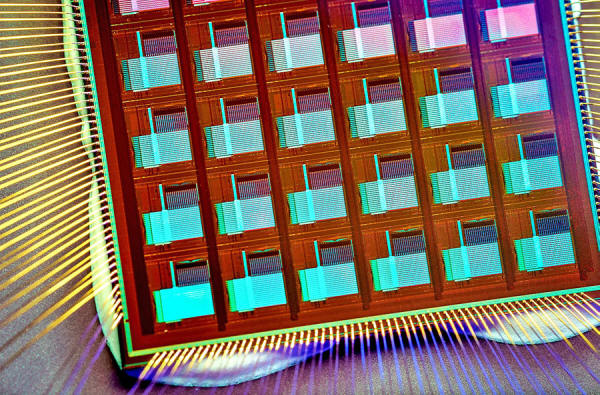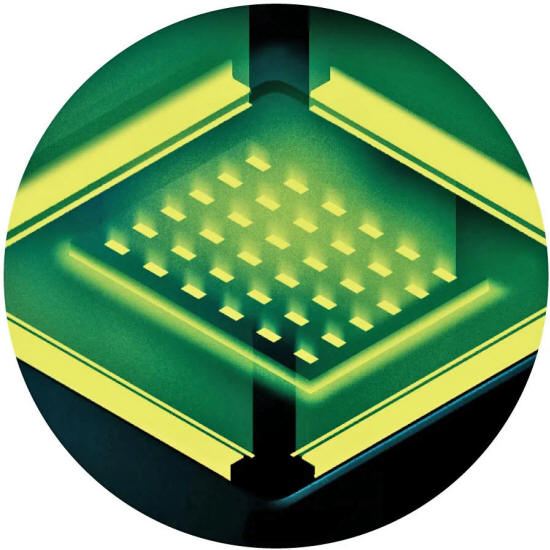|
for
Quanta Magazine fixes an old design flaw to run large-scale AI algorithms on smaller devices, reaching the same accuracy as wasteful digital computers...
Algorithms like deep neural networks - which are loosely inspired by the brain, with multiple layers of artificial neurons linked to each other via numerical values called weights - get bigger every year.
But these days, hardware improvements are no longer keeping pace with the enormous amount of memory and processing capacity required to run these massive algorithms.
Soon, the size of AI
algorithms may hit a wall.
The high carbon emissions
generated from running large AI algorithms is already harmful for
the environment, and it will only get worse as the algorithms grow
ever more gigantic.
That finally changed in August, when Weier Wan, H.-S. Philip Wong, Gert Cauwenberghs and their colleagues revealed a new neuromorphic chip called NeuRRAM that includes 3 million memory cells and thousands of neurons built into its hardware to run algorithms.
As a result, the new chip can perform as well as digital computers on complex AI tasks like image and speech recognition, and the authors claim it is up to 1,000 times more energy efficient, opening up the possibility for tiny chips to run increasingly complicated algorithms within small devices previously unsuitable for AI like smart watches and phones.
Researchers not involved in the work have been deeply impressed by the results.
Creating New Memories
In digital computers, the huge amounts of energy wasted while they run AI algorithms is caused by a simple and ubiquitous design flaw that makes every single computation inefficient.
Typically, a computer's memory - which holds the data and numerical values it crunches during computation - is placed on the motherboard away from the processor, where computing takes place.
For the information coursing through the processor,
The NeuRRAM chip can run computations within its memory, where it stores data not in traditional binary digits,
but in an analog spectrum.
Fixing this problem with new all-in-one chips that put memory and computation in the same place seems straightforward.
It's also closer to how our brains likely process information, since many neuroscientists believe that computation happens within populations of neurons, while memories are formed when the synapses between neurons strengthen or weaken their connections.
But creating such devices has proved difficult, since current forms of memory are incompatible with the technology in processors.
Computer scientists decades ago developed the materials to create new chips that perform computations where memory is stored - a technology known as compute-in-memory.
But with traditional digital computers performing so well, these ideas were overlooked for decades.
Indeed, the first such device dates back to at least 1964, when electrical engineers at Stanford discovered they could manipulate certain materials, called metal oxides, to turn their ability to conduct electricity on and off.
That's significant because a material's ability to switch between two states provides the backbone for traditional memory storage.
Typically, in digital memory, a state of high voltage corresponds to a 1, and low voltage to a 0.
Wong likens this process to lightning:
But unlike with lightning, whose path disappears, the path through the metal oxide remains, meaning it stays conductive indefinitely.
And it's possible to erase the conductive path by applying another voltage to the material. So researchers can switch an RRAM between two states and use them to store digital memory.
Midcentury researchers didn't recognize the potential for energy-efficient computing, nor did they need it yet with the smaller algorithms they were working with.
It took until the early 2000s, with the discovery of new metal oxides, for researchers to realize the possibilities.
Wong, who was working at IBM at the time, recalls that an award-winning colleague working on RRAM admitted he didn't fully understand the physics involved.
But in 2004, researchers at Samsung Electronics announced that they had successfully integrated RRAM memory built on top of a traditional computing chip, suggesting that a compute-in-memory chip might finally be possible.
Wong resolved to at least try...
Compute-in-Memory Chips for AI
For more than a decade, researchers like Wong worked to build up RRAM technology to the point where it could reliably handle high-powered computing tasks.
Around 2015, computer scientists began to recognize the enormous potential of these energy-efficient devices for large AI algorithms, which were beginning to take off.
That year, scientists at the University of California, Santa Barbara showed that RRAM devices could do more than just store memory in a new way.
They could execute basic computing tasks themselves,
In the NeuRRAM chip, silicon neurons are built into the hardware, and the RRAM memory cells store the weights - the values representing the strength of the connections between neurons.
And because the NeuRRAM memory cells are analog, the weights that they store represent the full range of resistance states that occur while the device switches between a low-resistance to a high-resistance state.
This enables even higher energy efficiency than digital RRAM memory can achieve because the chip can run many matrix computations in parallel - rather than in lockstep one after another, as in the digital processing versions.
But since analog processing is still decades behind digital processing, there are still many issues to iron out.
One is that analog RRAM chips must be unusually precise since imperfections on the physical chip can introduce variability and noise. (For traditional chips, with only two states, these imperfections don't matter nearly as much.)
That makes it significantly harder for analog RRAM devices to run AI algorithms, given that the accuracy of, say, recognizing an image will suffer if the conductive state of the RRAM device isn't exactly the same every time.
Wong and his colleagues proved that RRAM devices can store continuous AI weights and still be as accurate as digital computers if the algorithms are trained to get used to the noise they encounter on the chip, an advance that enabled them to produce the NeuRRAM chip.
H.-S. Philip Wong (left), Weier Wan and Gert Cauwenberghs (not pictured) helped build a new kind of computer chip that can run huge AI algorithms
with
unprecedented efficiency.
Another major issue they had to solve involved the flexibility needed to support diverse neural networks.
In the past, chip designers had to line up the tiny RRAM devices in one area next to larger silicon neurons. The RRAM devices and the neurons were hard-wired without programmability, so the computation could only be performed in a single direction.
To support neural networks with bidirectional computation, extra wires and circuits were necessary, inflating energy and space needs.
So Wong's team designed a new chip architecture where the RRAM memory devices and silicon neurons were mixed together.
This small change to the design reduced the total area and saved energy.
For several years, Wong's team worked with collaborators to design, manufacture, test, calibrate and run AI algorithms on the NeuRRAM chip.
They did consider using other emerging types of memory that can also be used in a compute-in-memory chip, but RRAM had an edge because of its advantages in analog programming, and because it was relatively easy to integrate with traditional computing materials.
Their recent results represent the first RRAM chip that can run such large and complex AI algorithms - a feat that has previously only been possible in theoretical simulations.
Now, Cauwenberghs said, their flexible, precise and energy-efficient analog RRAM chip has "bridged the gap for the first time."
Scaling Up
The team's design keeps the NeuRRAM chip tiny - just the size of a fingernail - while squeezing 3 million RRAM memory devices that can serve as analog processors.
And while it can run neural networks at least as well as digital computers do, the chip also (and for the first time) can run algorithms that perform computations in different directions.
Their chip can input a voltage to the rows of the RRAM array and read outputs from the columns as is standard for RRAM chips, but it can also do it backward from the columns to the rows, so it can be used in neural networks that operate with data flowing in different directions.
As with RRAM technology itself, this has long been possible, but no one thought to do it.
As examples, he mentioned the ability of a simple system to run the enormous algorithms needed for multidimensional physics simulations or self-driving cars.
Yet size is an issue.
The largest neural networks now contain billions of weights, not the millions contained in the new chips. Wong plans to scale up by stacking multiple NeuRRAM chips on top of each other.
It will be just as important to keep the energy costs low in future devices, or to scale them down even further.
One way to get there is by copying the brain even more closely to adopt the communication signal used between real neurons: the electrical spike.
It's a signal fired off from one neuron to another when the difference in the voltage between the inside and outside of the cell reaches a critical threshold.
To run algorithms that spike on the current NeuRRAM chip would likely require a totally different architecture, though, Kenyon noted.
For now, the energy efficiency the team accomplished while running large AI algorithms on the NeuRRAM chip has created new hope that memory technologies may represent the future of computing with AI.
Maybe one day we'll even be able to match the human brain's 86 billion neurons and the trillions of synapses that connect them without running out of power.
|






